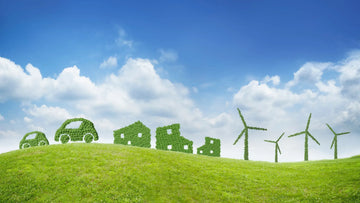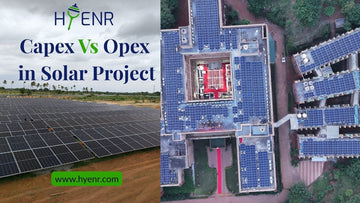Introduction
Clean energy options are becoming increasingly vital today as we face the pressing need for sustainable and environmentally friendly solutions. The importance of clean energy cannot be overstated, as it offers numerous benefits for both the planet and our future generations. The global shift towards clean energy sources marks a significant transition from traditional fuel sources, such as fossil fuels, towards renewable and cleaner alternatives. This transition is driven by the desire to reduce greenhouse gas emissions, combat climate change, and preserve natural resources. Renewable energy sources like solar, wind, and hydroelectric power play a pivotal role in meeting our energy needs while minimizing our environmental impact.
Sun Energy
- Solar power is a renewable energy source that harnesses the energy from the sun and converts it into electricity. This clean and abundant energy source offers several benefits. Firstly, solar power is environmentally friendly as it produces no greenhouse gas emissions, contributing to reduced carbon footprint and improved air quality. Secondly, solar power is renewable, meaning it will never run out, unlike finite fossil fuels. Additionally, solar power provides energy independence by allowing individuals and businesses to generate electricity. It also reduces reliance on traditional energy grids, contributing to a more resilient and decentralized energy system.
- Photovoltaic (PV) panels are the key components of solar energy systems. These panels consist of multiple solar cells that convert sunlight into direct current (DC) electricity. The photovoltaic effect occurs when sunlight hits the solar cells, causing electrons to get excited and flow as an electric current. PV panels are installed on rooftops, open fields, or solar farms to maximize exposure to sunlight. They are crucial in capturing and converting solar energy into usable electricity. Solar energy systems, comprised of PV panels, inverters, and batteries, allow for the generation and storage of solar power for various applications, from powering homes and businesses to providing electricity to remote areas and supporting off-grid systems. The efficiency and cost-effectiveness of PV panels continue to improve as technology advances and research continues, making solar power an increasingly viable and accessible clean energy option.
Wind Energy
- Description of Wind Turbines and Their Function in Wind Power Generation
Wind turbines are the essential components in harnessing wind energy for power generation. These towering structures consist of three main parts: the tower, the nacelle, and the blades. The building provides the height necessary to capture more robust, consistent winds at higher altitudes. The nacelle, positioned atop the tower, houses the gearbox, generator, and other critical components. The blades, typically made of fiberglass or other lightweight materials, capture the wind's kinetic energy.
The functioning of a wind turbine involves a simple yet effective process. As the wind blows, it causes the turbine blades to rotate. This rotational motion turns the shaft connected to the edges, spinning the generator inside the nacelle. The generator converts the mechanical energy from the rotating shaft into electrical energy, which is then distributed to the power grid.
- Overview of Wind Farms and Their Significance in Harnessing Wind Energy
Wind farms are large-scale collections of interconnected wind turbines strategically positioned across vast areas with consistent wind patterns. The significance of wind farms lies in their ability to harness wind energy on a broader scale efficiently. By aggregating multiple turbines into a centralized location, wind farms take advantage of economies of scale, reducing the overall cost of energy production.
Wind farms contribute significantly to the generation of clean and renewable electricity. They play a pivotal role in diversifying the energy mix and reducing dependence on fossil fuels, thereby mitigating the environmental impact of traditional power sources. The distributed nature of wind farms ensures that energy can be generated even in regions with moderate wind speeds, making wind power a viable and sustainable solution for a greener and more resilient energy future.
Exploring Diverse Clean Energy Options
- Definition of Diverse Clean Energy Technologies
Diverse clean energy technologies encompass many methods and systems to generate energy while minimizing environmental impact. These technologies prioritize sustainability, often relying on renewable resources or advanced processes to produce power. Diversification in clean energy ensures a comprehensive approach to address the growing energy demand while mitigating climate change and reducing reliance on finite fossil fuels.
- Discussion of Various Renewable Energy Sources and Their Potential Contributions
Solar Energy:
Solar power harnesses energy from the sun using photovoltaic cells or solar thermal systems. It is a versatile and abundant source, contributing to electricity generation and heating applications.
Wind Energy:
Wind turbines capture the wind's kinetic energy, converting it into electricity. Wind energy is scalable and often deployed in wind farms, significantly contributing to the renewable energy mix.
Hydropower:
Hydropower utilizes the energy of flowing water to generate electricity. It includes traditional hydroelectric dams and smaller-scale run-of-river systems, offering reliable and consistent power.
Geothermal Energy:
Geothermal energy taps into the Earth's internal heat for electricity generation and heating. It provides a continuous and stable source of power with minimal environmental impact.
Biomass Energy:
Biomass energy uses organic materials such as wood, agricultural residues, or biodegradable waste to produce heat or electricity. It is a versatile and renewable source with potential in various applications.
Ocean Energy:
Ocean energy encompasses tidal, wave, and ocean thermal energy conversion. These technologies harness the power of the ocean's movements and temperature gradients to generate electricity.
Nuclear Energy:
While controversial, nuclear energy is a low-carbon option that uses nuclear fission to produce electricity. Advanced technologies like small modular reactors aim to enhance safety and efficiency.
These renewable energy sources bring unique advantages and challenges, and their combined utilization contributes to a diversified and resilient clean energy landscape. These technologies' ongoing exploration and integration are crucial for creating a sustainable and secure energy future.
Clean Energy Solutions
- Importance of Energy Efficiency in Achieving Sustainable Development
Energy efficiency stands as a linchpin in achieving sustainable development. By optimizing the use of energy resources, we can reduce waste, lower emissions, and enhance overall environmental sustainability. Energy-efficient practices contribute to economic savings, strengthen energy security, and foster a healthier planet.
- Overview of Renewable Energy Systems and Their Applications
Renewable energy systems, driven by sources like solar, wind, and hydropower, play a pivotal role in a sustainable energy future. Their applications span electricity generation, heating, and even transportation. The versatility of these systems contributes to a diversified and resilient energy landscape, reducing dependence on fossil fuels.
Environmental Impact
- Examination of Greenhouse Gas Emissions and Their Effects
An examination of greenhouse gas emissions reveals their profound impact on climate change. Burning fossil fuels releases carbon dioxide and other pollutants, contributing to global warming, rising sea levels, and extreme weather events. Transitioning to clean energy is imperative to mitigate these effects.
- Explanation of Carbon Footprint Reduction Through Clean Energy Adoption
Clean energy adoption is a direct pathway to reducing carbon footprints. Shifting to renewable sources diminishes reliance on fossil fuels, leading to lower emissions. These technologies, from solar panels to wind turbines, offer a tangible means to combat climate change and minimize our environmental impact.
Energy Conservation and Innovation
- Discussion on Energy Conservation Practices
Energy conservation practices are crucial for sustainability. Simple actions like using energy-efficient appliances, turning off lights when not in use, and optimizing heating and cooling systems collectively contribute to significant energy savings. Conservation efforts empower individuals and businesses to actively participate in creating a sustainable energy future.
- Introduction to Emerging Technologies such as Electric Vehicles and Energy Storage Solutions
The landscape of energy conservation is evolving with the introduction of innovative technologies. Electric vehicles (EVs) reduce dependence on fossil fuels in the transportation sector, while energy storage solutions, like advanced batteries, contribute to grid stability and flexibility. These innovations showcase the potential for a more sustainable and efficient energy ecosystem.
Conclusion
- Recap of the Benefits and Potential of Diversified Clean Energy Options
In conclusion, diversified clean energy options offer many benefits, including reduced environmental impact, enhanced energy security, and economic savings. The versatility of renewable energy systems and emerging technologies position us for a sustainable and resilient future.
- Encouragement for Continued Exploration and Adoption of Renewable Energy Sources
As we recap these benefits, the journey toward a cleaner energy future requires continued exploration and widespread adoption of renewable energy sources. Encouraging individuals, businesses, and governments to embrace clean energy solutions is essential for creating a world powered by sustainable and environmentally friendly practices. The collective effort towards a greener future is both a responsibility and an opportunity for present and future generations.





